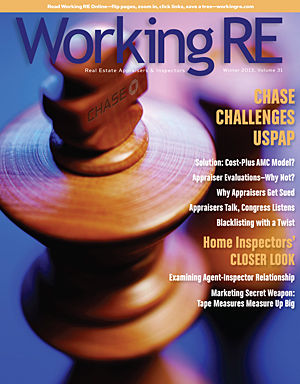|
Published by OREP, E&O Insurance Experts | February 2013 |

Click to Read Current Issue |
|
Jack Feldmann, a home
inspector from Tennessee, explains that most Standards of Practice (SOP) for
home inspector associations define what is "readily accessible" and allow
inspectors to pull the "I can't get to it, so I'm not inspecting it" card if
they so choose.
Editor's Note: Want to know how home inspectors think? This insightful exchange between home inspectors about if, and when, to move a seller's personal property to perform a thorough home inspection will be of interest to both buyer and seller agents.
Playing
the "Not Readily Accessible" Inspection Card
By Isaac Peck
From a pad-locked electrical panel to an obstructed attic, sooner or later
every home inspector encounters a situation where something is “not readily
accessible.”
Some inspectors say it’s a disservice to their clients to not go the extra
mile (including moving personal property) to access items requiring
inspection. Others insist that any
extra steps taken by the home inspector to gain access, such as moving
personal property or unscrewing an access door, needlessly increase the home
inspector’s liability and create added risk.
Jack Feldmann, a home inspector from Tennessee, explains that most Standards
of Practice (SOP) for home inspector associations define what is “readily
accessible” and allow inspectors to pull the “I can’t get to it, so I’m not
inspecting it” card if they so choose.
Feldmann also points out that most home inspection agreements absolve
the home inspector of the responsibility of reporting on items and areas
that they couldn’t access.
For instance, InterNACHI’s Home Inspection Standards state: “The
inspector is not required to move any personal items or other obstructions,
such as, but not limited to, throw rugs, carpeting, wall coverings,
furniture, ceiling tiles, window coverings, equipment, plants, ice, debris,
snow, water, dirt, pets, or anything else that might restrict the visual
inspection.”
ASHI’s (American Society of Home Inspectors) SOP are very similar, stating
that the inspector is not required to “move personal property, furniture,
equipment, plants, soil, snow, ice or debris.”
Despite this, Feldmann feels that he owes it to his clients to do the most
thorough job possible, within reason of course.
He explains, “If the electrical panel or crawlspace door has a padlock on
it, I will call the listing agent and ask them to get in touch with the
property owner and see if there is a key somewhere in the house. If they
cannot get in contact with the seller, I ask permission (from the listing
agent) to cut the lock.” In his 23 years of home inspecting, he says that he
has never had a seller or listing agent refuse to let him cut the lock.
“Each and every time, I offer to replace the padlock. Most of the
time they tell me not to bother,” Feldmann says.
(story continues below)

(story continues)
Feldmann explains that he takes this same approach with crawlspaces that are
blocked off. “I have gone to crawlspaces and found the access panel screwed
in place and I have always just removed the screws, and replaced them when I
was done. According to my SOP, I could have disclaimed getting into the
crawlspace, however I would have shortchanged my client by not inspecting
one of the most important components of the house,” says Feldmann.
Despite his desire to be as thorough as possible, Feldmann says that he
always considers his potential risk and liability before moving anything.
And he does occasionally use the disclaimer: “Not Readily Accessible” in his
reports. For instance, attic access is frequently blocked by owner’s
belongings in the closet. Feldmann says that if the seller or the seller’s
agent is present, he will ask them to help him move the belongings, but when
he’s alone it really depends on the potential risk involved in moving the
items. “If I am by myself, I will make the determination if I want to move
their stuff or not. It depends on what is stored and the potential risk for
damage/liability. Frankly, I hate doing this!”
Feldmann says that he’s only had one complaint so far-- one seller filed a
claim with the Better Business Bureau alleging that he damaged her clothes.
Fortunately for Feldmann, he says he was able to settle the claim with an
eight-dollar check for cleaning costs.
Just Saying No
On the other hand, some home inspectors simply refuse to move any of the
seller’s personal belongings due to liability concerns.
Aaron Miller, a home inspector from Texas, says that he doesn’t move
anything that doesn’t belong to him.
“If it is not readily accessible, it gets disclaimed. I am an inspector, not
a moving company,” says Miller.
When asked about his responsibility to perform as thorough an investigation
as possible, Miller insists that his approach is as per his inspection
agreement and his SOP. “My clients are fully-informed at least a day or two
in advance of the inspection as to what the inspection covers and what it
does not cover. I explain such things preemptively in my inspection
agreement. Everyone is aware of whose responsibility it is to make things
accessible for me prior to that time.
My policies are in alignment with the state and ASHI SOP. They are
also in place to protect the seller's property and to reduce mine and my
client's liability should something become damaged due to my moving it,”
says Miller.
Greg Filian, from
Mobile Home Inspectors,
says that he tries to take a balanced approach when it comes to deciding
what to move. “My policy on moving things is, if it looks like the resident
moves the items all the time, I will move them- trash cans, hanging clothes,
lawn mowers, etc. If items are never or nearly never moved, like beds,
couches dressers, parked car, storage in a closet, I don't move them and
disclose it. I have a standard disclosure for this,” says Filian.
Filian explains that sometimes it comes down to common sense and experience.
“Let’s face it, sometimes you just can't get to it. No inspection fee is
worth me paying for damage or hurting myself. If there are clothes in the
washing machine or dryer and no one is there to move them I don't run the
appliances or touch the clothes.
Once I shrunk a ‘favorite’ piece of clothing and had to pay for it.
I've done this long enough to have learned from mistakes I've made and then
incorporate them into my business,” Filian says.
Christopher Chirafisi, Director of Technical
Training at AHIT, agrees that common sense plays a very important role in
these decisions. “If I am performing an inspection and the electric panel
has some boxes or some other personal property blocking access to it, I have
a few options. I can ask the seller (if the seller is home) to move
the storage, or I can follow the Standards and document in the report that
the ‘electrical panel was inaccessible, blocked by sellers personal
property’ and document that the panel was not evaluated. Conversely, I can
decide to move the boxes myself and try to inspect the panel,” Chirafisi
explains.
Chirafisi says that if it is safe to move the boxes without damaging any of
the seller’s personal property, he believes the best thing to do is to move
the boxes to gain access to
the electrical panel and perform a proper inspection of it. “I can’t speak
for every inspector but I think it is the duty of the home inspector to have
the best interest of the person buying that house in mind and make sure the
major systems are safe. Inspectors should try their very best to access all
systems and inspect them thoroughly,” Chirafisi says.
Nick Gromiko, Founder of InterNACHI, had this advice for home inspectors:
"If you can move it safely without hurting yourself or the item…. I say move
it. There are a lot of things in business that you should do, even though
you are not technically required to do them."
The decision to move personal property, unscrew a panel, or “get
access” to obstructed areas during an inspection is something that each home
inspector approaches differently based on their experiences, risk-appetite,
and home inspecting style.
Editor's Question: As a real estate agent/broker, how far
do you go to ensure the home inspector will have access to all critical
components of the house? Do you often see "Not Readily Accessible" on home
inspection reports?
About the Author
Isaac Peck is the Associate Editor of Working RE
Magazine and Marketing Coordinator at
OREP.org, a leading provider of
E&O Insurance for appraisers, inspectors, and other real estate
professionals in 49 states. He received his Bachelors in Business Management
at San Diego State University. He can be contacted at
Isaac@orep.org or 888-347-5273.
ATTENTION: You are receiving WRE Online News because you opted in at WorkingRE.com or purchased E&O insurance from OREP. WRE Online News Edition provides news-oriented content twice a month. The content for WRE Special Offer Editions is provided by paid sponsors. If you no longer wish to receive these emails from Working RE, please use the link found at the bottom of this newsletter to be removed from our mailing list.



